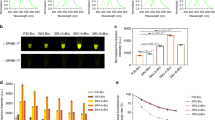Abstract
Fluorescent protein reporters have been widely used for monitoring the expression of target genes in various engineered organisms. Although a wide range of analytical approaches (e.g., genoty** PCR, digital PCR, DNA sequencing) have been utilized to detect and identify genome editing reagents and transgene expression in genetically modified plants, these methods are usually limited to use in the late stages of plant transformation and can only be used invasively. Here we describe GFP- and eYGFPuv-based strategies and methods for assessing and detecting genome editing reagents and transgene expression in plants, including protoplast transformation, leaf infiltration, and stable transformation. These methods and strategies enable easy, noninvasive screening of genome editing and transgenic events in plants.
Access this chapter
Tax calculation will be finalised at checkout
Purchases are for personal use only
Similar content being viewed by others
References
Bailey-Serres J, Parker JE, Ainsworth EA, Oldroyd GED, Schroeder JI (2019) Genetic strategies for improving crop yields. Nature 575:109–118
Dong OX, Ronald PC (2019) Genetic engineering for disease resistance in plants: recent progress and future perspectives. Plant Physiol 180:26–38
Yuan G, Lu H, Tang D, Hassan MM, Li Y et al (2021) Expanding the application of a UV-visible reporter for transient gene expression and stable transformation in plants. Hortic Res 8:234
Yuan G, Lu H, Weston DJ, Jawdy S, Tschaplinski TJ et al (2022) Reporter genes confer new-to-nature ornamental traits in plants. Hortic Res 9:uhac077
Ma X, Zhu Q, Chen Y, Liu Y-G (2016) CRISPR/Cas9 platforms for genome editing in plants: developments and applications. Mol Plant 9:961–974
Anzalone AV, Randolph PB, Davis JR, Sousa AA, Koblan LW et al (2019) Search-and-replace genome editing without double-strand breaks or donor DNA. Nature 576:149–157
Li C, Zong Y, Wang Y, ** S, Zhang D et al (2018) Expanded base editing in rice and wheat using a Cas9-adenosine deaminase fusion. Genome Biol 19:59
Yuan G, Hassan MM, Yao T, Lu H, Vergara MM et al (2021) Plant-based biosensors for detecting CRISPR-mediated genome engineering. ACS Synth Biol 10:3600–3603
Yuan G, Lu H, De K, Hassan MM, Liu Y et al (2022) An intein-mediated split–nCas9 system for base editing in plants. ACS Synth Biol 11:2513
Osmond ATY, Colombo SM (2019) The future of genetic engineering to provide essential dietary nutrients and improve growth performance in aquaculture: advantages and challenges. J World Aquacult Soc 50:490–509
Tuskan GA, DiFazio S, Jansson S, Bohlmann J, Grigoriev I et al (2006) The genome of black cottonwood, Populus trichocarpa (Torr. & Gray). Science 313:1596–1604
Vickers CE, Schenk PM, Li D, Mullineaux PM, Gresshoff PM (2007) pGFPGUSPlus, a new binary vector for gene expression studies and optimising transformation systems in plants. Biotechnol Lett 29:1793–1796
Yoo S-D, Cho Y-H, Sheen J (2007) Arabidopsis mesophyll protoplasts: a versatile cell system for transient gene expression analysis. Nat Protoc 2:1565–1572
Guo J, Morrell-Falvey JL, Labbé JL, Muchero W, Kalluri UC et al (2012) Highly efficient isolation of Populus mesophyll protoplasts and its application in transient expression assays. PLoS One 7:e44908
Acknowledgments
The authors are grateful to C.A. Eckert (Oak Ridge National Laboratory, Oak Ridge, TN, USA) for editing the manuscript. The writing of this manuscript was supported by the Center for Bioenergy Innovation, a US Department of Energy (DOE) Bioenergy Research Center supported by the Biological and Environmental Research (BER) program, and the US DOE BER Genomic Science Program, as part of the Secure Ecosystem Engineering and Design (SEED) Scientific Focus Area. Oak Ridge National Laboratory is managed by UT-Battelle, LLC for the US Department of Energy under Contract Number DE-AC05-00OR22725.
Disclosure
This manuscript has been authored by UT-Battelle, LLC under Contract No. DE-AC05-00OR22725 with the US Department of Energy. The US Government retains and the publisher, by accepting the article for publication, acknowledges that the US Government retains a nonexclusive, paid-up, irrevocable, worldwide license to publish or reproduce the published form of this manuscript, or allow others to do so, for the US Government purposes. The Department of Energy will provide public access to these results of federally sponsored research in accordance with the DOE Public Access Plan (http://energy.gov/downloads/doe-public-access-plan).
Author information
Authors and Affiliations
Corresponding authors
Editor information
Editors and Affiliations
Rights and permissions
Copyright information
© 2023 The Author(s), under exclusive license to Springer Science+Business Media, LLC, part of Springer Nature
About this protocol
Cite this protocol
Yuan, G., Tuskan, G.A., Yang, X. (2023). Use of Fluorescent Protein Reporters for Assessing and Detecting Genome Editing Reagents and Transgene Expression in Plants. In: Yang, B., Harwood, W., Que, Q. (eds) Plant Genome Engineering. Methods in Molecular Biology, vol 2653. Humana, New York, NY. https://doi.org/10.1007/978-1-0716-3131-7_8
Download citation
DOI: https://doi.org/10.1007/978-1-0716-3131-7_8
Published:
Publisher Name: Humana, New York, NY
Print ISBN: 978-1-0716-3130-0
Online ISBN: 978-1-0716-3131-7
eBook Packages: Springer Protocols




